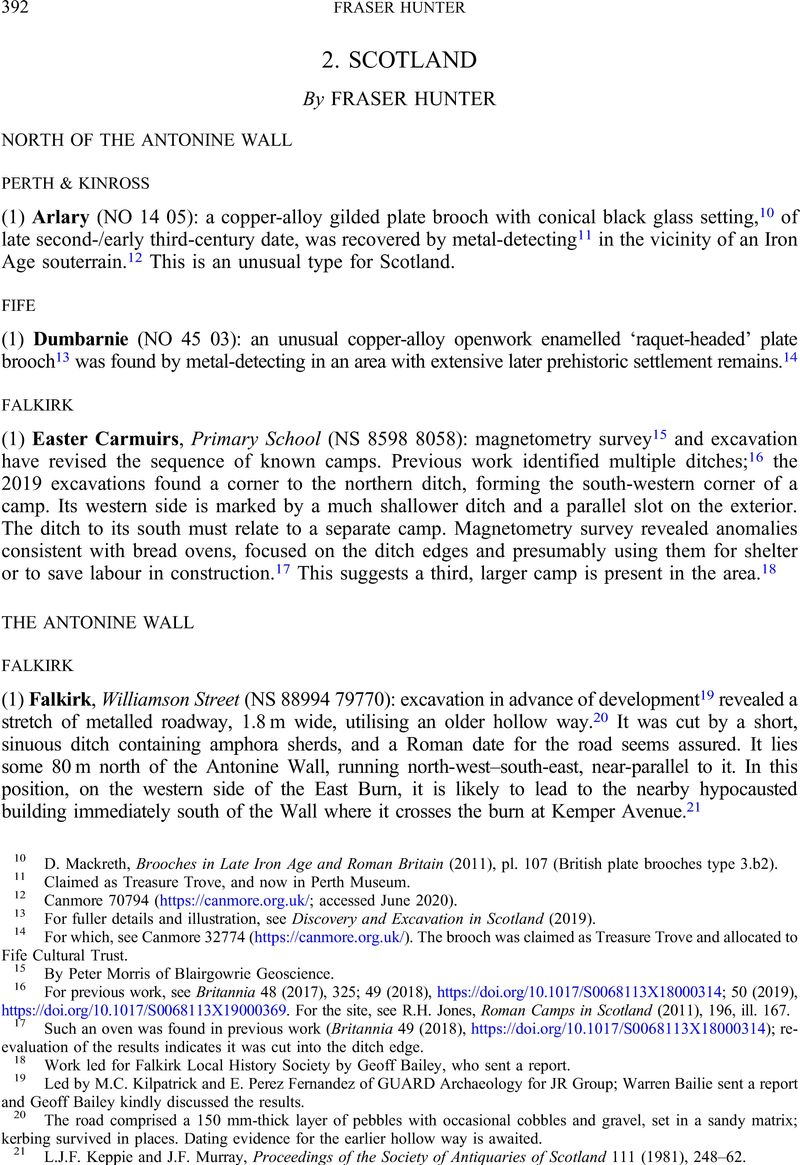No CrossRef data available.
Article contents
2. SCOTLAND
Published online by Cambridge University Press: 16 September 2020
Abstract

Information
- Type
- Roman Britain in 2019
- Information
- Copyright
- Copyright © The Authors, 2020. Published by Cambridge University Press on behalf of The Society for the Promotion of Roman Studies
References
10 D. Mackreth, Brooches in Late Iron Age and Roman Britain (2011), pl. 107 (British plate brooches type 3.b2).
11 Claimed as Treasure Trove, and now in Perth Museum.
12 Canmore 70794 (https://canmore.org.uk/; accessed June 2020).
13 For fuller details and illustration, see Discovery and Excavation in Scotland (2019).
14 For which, see Canmore 32774 (https://canmore.org.uk/). The brooch was claimed as Treasure Trove and allocated to Fife Cultural Trust.
15 By Peter Morris of Blairgowrie Geoscience.
16 For previous work, see Britannia 48 (2017), 325; 49 (2018), https://doi.org/10.1017/S0068113X18000314; 50 (2019), https://doi.org/10.1017/S0068113X19000369. For the site, see R.H. Jones, Roman Camps in Scotland (2011), 196, ill. 167.
17 Such an oven was found in previous work (Britannia 49 (2018), https://doi.org/10.1017/S0068113X18000314); re-evaluation of the results indicates it was cut into the ditch edge.
18 Work led for Falkirk Local History Society by Geoff Bailey, who sent a report.
19 Led by M.C. Kilpatrick and E. Perez Fernandez of GUARD Archaeology for JR Group; Warren Bailie sent a report and Geoff Bailey kindly discussed the results.
20 The road comprised a 150 mm-thick layer of pebbles with occasional cobbles and gravel, set in a sandy matrix; kerbing survived in places. Dating evidence for the earlier hollow way is awaited.
21 Keppie, L.J.F. and Murray, J.F., Proceedings of the Society of Antiquaries of Scotland 111 (1981), 248–62Google Scholar.
22 Led by Geoff Bailey, who sent a report, for Falkirk Local History Society.
23 For which, see R. Jackson, ‘Roman bound captives: symbols of slavery?’, in N. Crummy (ed.), Image, Craft and the Classical World (2005), 143–56.
24 For Falkirk Local History Society by Geoff Bailey, who sent a report. For previous work, see Britannia 50 (2019), 412.
25 For Falkirk Local History Society by Geoff Bailey, who sent a report.
26 By S. Kinirons, A.-A. Marot and S. Wilson of AOC Archaeology Group for Dandara Ltd; Martin Cook sent a report.
27 For which see Maxfield, V.A., Proceedings of the Society of Antiquaries of Scotland 105 (1972–74), 141–50Google Scholar; R.H. Jones, Roman Camps in Scotland (2011), 201–2.
28 Similar to that excavated by Maxfield (op. cit.) in the eastern entrance of Camp A.
29 The apparent terminal may be a later feature cutting the ditch. Waterlogged material in the base should assist in dating its primary phase.
30 Piggott, S., Proceedings of the Society of Antiquaries of Scotland 85 (1950–51), 92–117Google Scholar.
31 Claimed as Treasure Trove; now in National Museums Scotland.
32 Claimed as Treasure Trove; now in Dumfries Museum.

